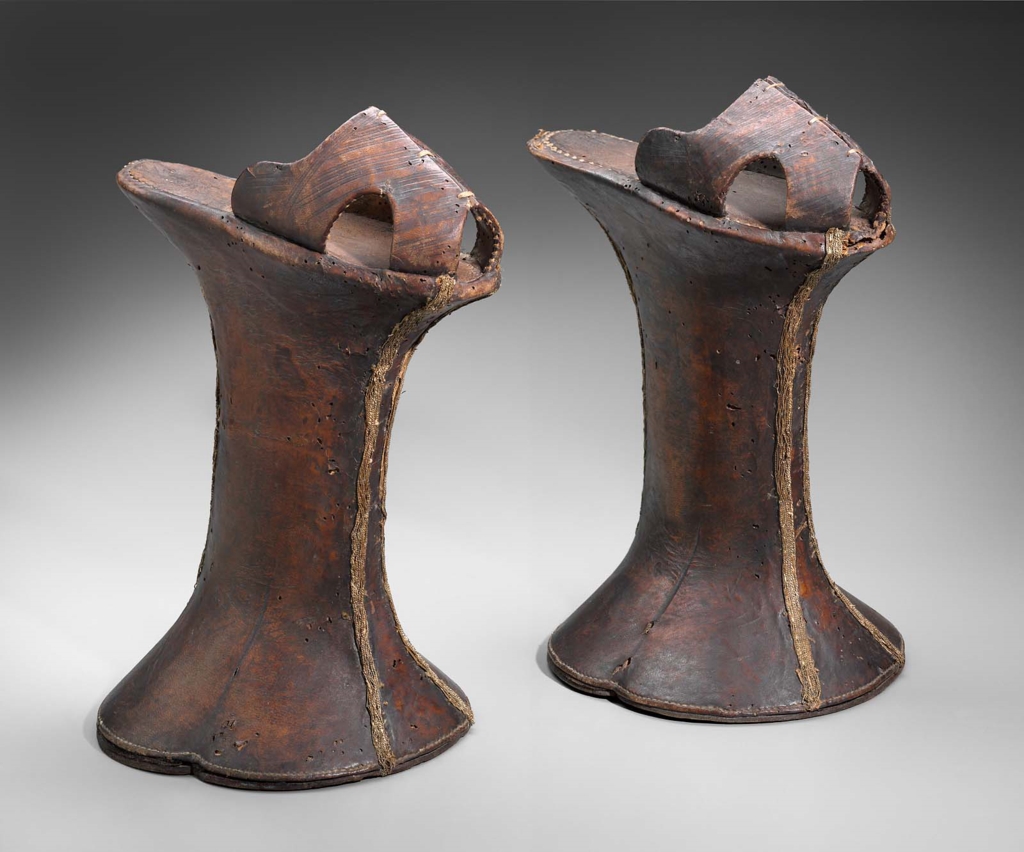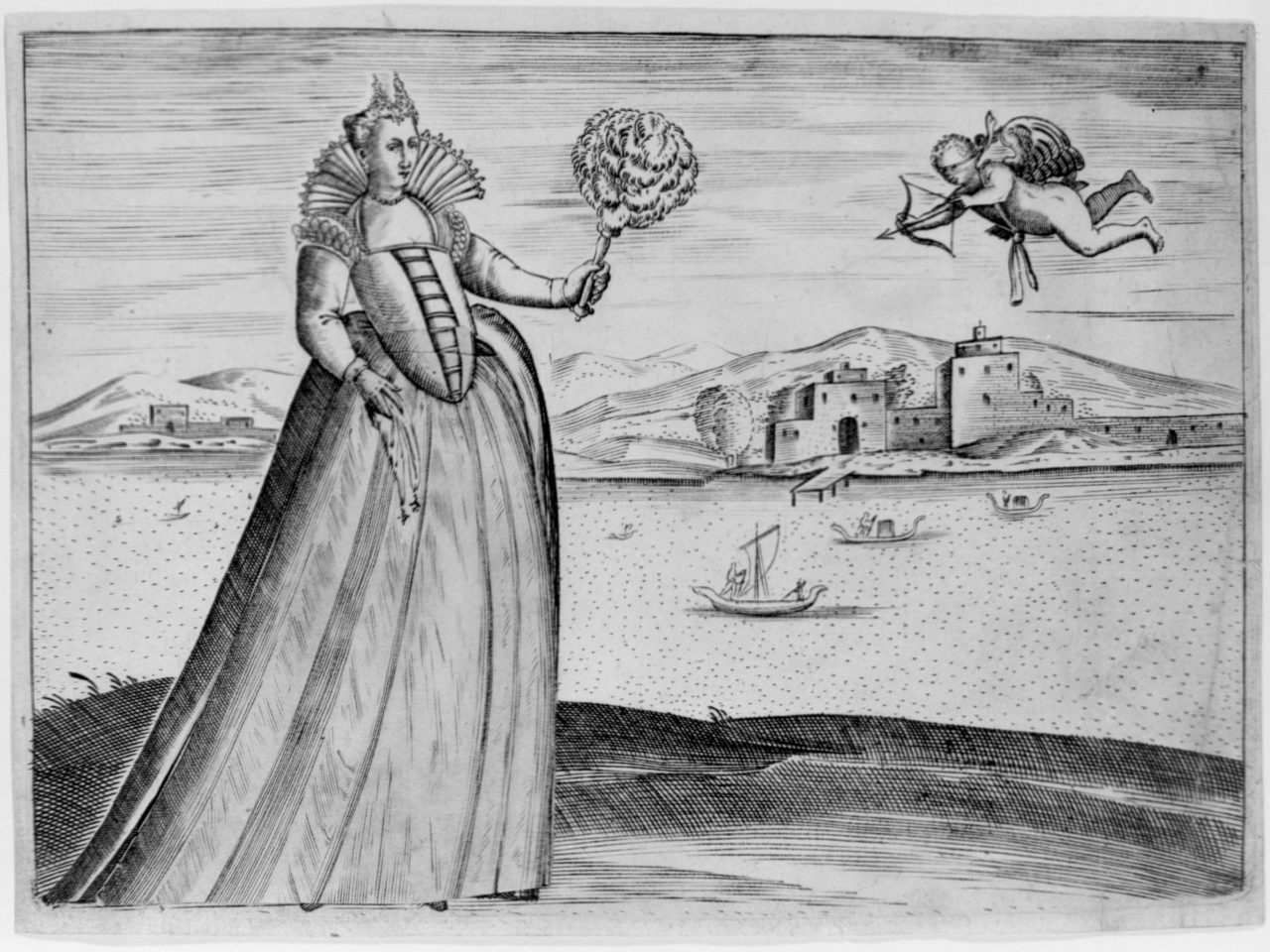High platform shoes worn mostly in Venice in the 16th & 17th centuries.
The Details
Shoes: A Brief History (2015) by Lucy Johnson and Linda Woolley describes chopines and notes a possible origin of the style:
“The chopine was one of the most extreme and artificial styles of footwear ever created… It could reach a height of over 18 inches (50 cms), but this extreme seems to have been confined to Italy and possibly Spain. It probably originated in Venice and was first worn by prostitutes, but was then adopted by fashionable Venetian aristocrats. The style derived from the Turkish bath shoe which kept the feet of the wearer out of the water.” (19)
A c. 1600 pair (Fig. 1) reflect this possible Turkish influence in their use of dual platforms, typical of Turkish nalins. An example of the extreme height of chopines can be seen in the tooled leather Venetian pair in figure 2.
The height of chopines meant that dresses worn with them required longer hemlines and thus the consumption of more expensive dress textiles. This can be seen in a 1580s print (Figs. 3-4), which shows a Venetian woman wearing chopines and an extremely long skirt to compensate.
Fig. 1 - Maker unknown (Italian). Chopines, ca. 1600. Leather, silk, wood. New York: The Metropolitan Museum of Art, 1973.114.4a, b. Purchase, Irene Lewisohn Bequest, 1973. Source: The Metropolitan Museum of Art
Fig. 2 - Maker unknown (Italian/Venetian). Pair of women's platform shoes (chopines), 1590–1610. Tooled leather over wood, with metallic braid; 30.2 x 16.2 x 24 cm (11 7/8 x 6 3/8 x 9 7/16 in). Boston: The Museum of Fine Arts, 44.556a-b. The Elizabeth Day McCormick Collection. Source: The Museum of Fine Arts, Boston
Fig. 3 - Published by Ferrando Bertelli (active Venice, 1561–71). Venetian Woman with Moveable Skirt, 1563. Engraving; 14 x 18.9 cm (5 1/2 x 7 7/16 in). New York: The Metropolitan Museum of Art, 55.503.30. The Elisha Whittelsey Collection, The Elisha Whittelsey Fund, 1955. Source: The Metropolitan Museum of Art
Fig. 4 - Published by Ferrando Bertelli (active Venice, 1561–71). Venetian Woman with Moveable Skirt, 1563. Engraving; 14 x 18.9 cm (5 1/2 x 7 7/16 in). New York: The Metropolitan Museum of Art, 55.503.30. The Elisha Whittelsey Collection, The Elisha Whittelsey Fund, 1955. Source: The Metropolitan Museum of Art
The longer length of dresses worn with chopines could help balance proportions, as Phyllis Tortora and Sara Marcketti note in their Survey of Historic Costume (2015) about chopine use in Spain:
“Sleeves were full and slashed to show contrasting underlinings and generally ended in fitted cuffs. With these dresses women wore high chopines with wooden or cork soles that helped to elongate the figure somewhat to compensate for the width of the guardinfante.” (242)
In the History of World Costume and Fashion (2011) Daniel Delis Hill suggests that Asia could be the origin of chopines, where they were also worn with extra long hemlines:
“These platform shoes possibly were adapted from similar types brought from China and Japan. Depictions of women wearing chopines in paintings and drawings of late 1500s show either an extra long skirt with a hemline at the ground completely concealing the shoes or a regular hemline that covered only the tops of the shoes but left exposed the tall platforms.” (363)
Chopines were often beautifully decorated, sometimes, as in this example (Fig. 5), with metallic lace trim. The Museum of Fine Arts, Boston describes the elaborate ornamentation:
“Wood or cork stilt covered with velvet, gilt-silver lace in vegetative motif and brass tacks along bottom, gilt-silver galloon at front and back, pink and white silk tassel depends from toe.”
The Metropolitan Museum of Art explains a more practical purpose of height of some chopines, like the squatter pair in their collection (Fig. 6): “The thick-soled, raised shoe was designed to protect the foot from irregularly paved and wet or muddy streets.”
Yet, while some chopines may have been practical, like many elaborate high heels today, chopines were beautiful and inconvenient, making them a status symbol of the time.
Fig. 5 - Maker unknown (Italian/Venetian). A pair of women's chopines, Late 17th–early 18th century. Silk cut velvet with gilt-metal lace trim and linen lining, silk satin ribbon, metallic woven trim, metal nails, wood, and leather; 14 x 11.1 x 23 cm (5 1/2 x 4 3/8 x 9 1/16 in). Boston: The Museum of Fine Arts, 46.770b. The Elizabeth Day McCormick Collection. Source: The Museum of Fine Arts, Boston
Fig. 6 - Maker unknown (Italian/Venetian). Chopines, 1600. Painted and punched leather, leather, wood or cork; 9 x 11.8 x 22.8 cm (3 9/16 x 4 5/8 x 9 in). Boston: The Museum of Fine Arts, 44.523a-b. The Elizabeth Day McCormick Collection. Source: The Museum of Fine Arts, Boston
References:
- Koda, Harold. “The Chopine.” The Met’s Heilbrunn Timeline of Art History, 2002. https://www.metmuseum.org/toah/hd/chop/hd_chop.htm.
- Hill, Daniel Delis. History of World Costume and Fashion. Upper Saddle River, N.J: Pearson Prentice Hall, 2011. http://www.worldcat.org/oclc/939043732.
- Johnston, Lucy, Linda Woolley, and and Albert Museum Victoria. Shoes: A Brief History. London: V & A Publishing, 2015. http://www.worldcat.org/oclc/919291265.
- “One of a Pair of Women’s Chopines.” Museum of Fine Arts, Boston. March 16, 2018. Accessed December 16, 2018. https://www.mfa.org/collections/object/one-of-a-pair-of-womens-chopines-610127.
- Tortora, Phyllis G., and Sara B. Marcketti. Survey of Historic Costume. Sixth edition. New York, NY: Fairchild Books, 2015. http://www.worldcat.org/oclc/910929404.















